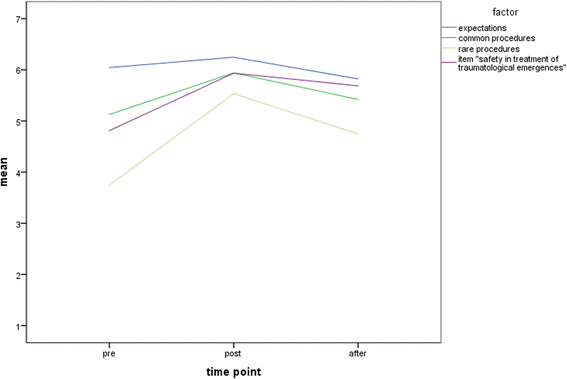Subjective safety and self-confidence in prehospital trauma care and learning progress after trauma-courses: part of the prospective longitudinal mixed-methods EPPTC-trial
- PMID: 28806988
- PMCID: PMC5557465
- DOI: 10.1186/s13049-017-0426-5
Subjective safety and self-confidence in prehospital trauma care and learning progress after trauma-courses: part of the prospective longitudinal mixed-methods EPPTC-trial
Abstract
Background: Prehospital trauma care is stressful and requires multi-professional teamwork. A decrease in the number of accident victims ultimately affects the routine and skills and underlines the importance of effective training. Standardized courses, like PHTLS, are established for health care professionals to improve the prehospital care of trauma patients. The aim of the study was to investigate the subjective safety in prehospital trauma care and learning progress by paramedics in a longitudinal analysis.
Methods: This was a prospective intervention trial and part of the mixed-method longitudinal EPPTC-trial, evaluating subjective and objective changes among participants and real patient care as a result of PHTLS courses. Participants were evaluated with pre/post questionnaires as well as one year after the course.
Results: We included 236 datasets. In the pre/post comparison, an increased performance could be observed in nearly all cases. The result shows that the expectations of the participants of the course were fully met even after one year (p = 0.002). The subjective safety in trauma care is significantly better even one year after the course (p < 0.001). Regression analysis showed that (ABCDE)-structure is decisive (p = 0.036) as well as safety in rare and common skills (both p < 0.001). Most skills are also rated better after one year. Knowledge and specific safety are assessed as worse after one year.
Conclusion: The courses meet the expectations of the participants and increase the subjective safety in the prehospital care of trauma patients. ABCDE-structure and safety in skills are crucial. In the short term, both safety in skills and knowledge can be increased, but the courses do not have the power to maintain knowledge and specific subjective safety issues over a year.
Trial registration: German Clinical Trials Register, ID DRKS00004713 , registered 14. February 2014.
Keywords: Allied health personnel; Competence; Learning progress; Safety; Self-confidence; Skill; Structure; Trauma care.
Conflict of interest statement
Ethics approval and consent to participate
The Ethics Committee of the Medical Faculty of the Eberhard Karls University of Tuebingen and the University Hospital approved the study proposal, number 197/2013BO2, on May 24, 2013. The study is registered in the German Clinical Trials Register with the ID DRKS00004713. Informed consent was obtained from all individual participants included in the study.
Consent for publication
Data collection, coding, routing and analysis were in accordance with data protection policy of Tübingen University. Participants gave written consent for analysis and publication, without showing individual personal data.
Competing interests
DH is PHTLS instructor. The other authors declare that they have no competing interests.
Publisher’s Note
Springer Nature remains neutral with regard to jurisdictional claims in published maps and institutional affiliations.
Figures
Similar articles
-
Quality of Documentation as a Surrogate Marker for Awareness and Training Effectiveness of PHTLS-Courses. Part of the Prospective Longitudinal Mixed-Methods EPPTC-Trial.PLoS One. 2017 Jan 20;12(1):e0170004. doi: 10.1371/journal.pone.0170004. eCollection 2017. PLoS One. 2017. PMID: 28107394 Free PMC article.
-
The effect of paramedic training on pre-hospital trauma care (EPPTC-study): a study protocol for a prospective semi-qualitative observational trial.BMC Med Educ. 2014 Feb 15;14:32. doi: 10.1186/1472-6920-14-32. BMC Med Educ. 2014. PMID: 24528532 Free PMC article.
-
PHTLS ® (Prehospital Trauma Life Support) provider courses in Germany - who takes part and what do participants think about prehospital trauma care training?J Trauma Manag Outcomes. 2014 Jul 7;8:7. doi: 10.1186/1752-2897-8-7. eCollection 2014. J Trauma Manag Outcomes. 2014. PMID: 25050135 Free PMC article.
-
Efficacy of Trauma Surgery Technical Skills Training Courses.J Surg Educ. 2019 May-Jun;76(3):832-843. doi: 10.1016/j.jsurg.2018.10.004. Epub 2019 Mar 1. J Surg Educ. 2019. PMID: 30827743
-
Mapping the use of simulation in prehospital care - a literature review.Scand J Trauma Resusc Emerg Med. 2014 Mar 28;22:22. doi: 10.1186/1757-7241-22-22. Scand J Trauma Resusc Emerg Med. 2014. PMID: 24678868 Free PMC article. Review.
Cited by
-
Evaluating the effectiveness of the pre‑hospital trauma life support (PHTLS) program for the management of trauma patients in the pre-hospital emergency based on Kirkpatrick's evaluation model.Int J Emerg Med. 2024 Jan 29;17(1):13. doi: 10.1186/s12245-024-00589-2. Int J Emerg Med. 2024. PMID: 38287277 Free PMC article.
-
Training to identify red flags in the acute care of trauma: who are the patients at risk for early death despite a relatively good prognosis? An analysis from the TraumaRegister DGU®.World J Emerg Surg. 2020 Aug 3;15(1):47. doi: 10.1186/s13017-020-00325-0. World J Emerg Surg. 2020. PMID: 32746874 Free PMC article.
-
Workshop-based training of pre-hospital emergency technicians for acute psychiatric patients: benefits and drawbacks.BMC Med Educ. 2024 Sep 12;24(1):996. doi: 10.1186/s12909-024-05856-7. BMC Med Educ. 2024. PMID: 39267028 Free PMC article.
-
[Best practice-example of a paramedic competence system in the context of user and patient safety: the Reutlinger Weg].Notf Rett Med. 2022 Mar 2:1-12. doi: 10.1007/s10049-022-00989-y. Online ahead of print. Notf Rett Med. 2022. PMID: 35261560 Free PMC article. Review. German.
-
[ECG interpretation in rescue and emergency medical services in Germany: results of a cross-sectional study].Med Klin Intensivmed Notfmed. 2025 Feb 25. doi: 10.1007/s00063-025-01252-1. Online ahead of print. Med Klin Intensivmed Notfmed. 2025. PMID: 39998639 German.
References
-
- Valentin B, Grottke O, Skorning M, Bergrath S, Fischermann H, Rörtgen D, et al. Cortisol and alpha-amylase as stress response indicators during pre-hospital emergency medicine training with repetitive high-fidelity simulation and scenarios with standardized patients. Scand J Trauma Resusc Emerg Med. 2015;23:1–8. doi: 10.1186/s13049-015-0110-6. - DOI - PMC - PubMed
-
- Gebhardt H. Sicherheit und Gesundheit im Rettungsdienst. Bundesanstalt für Arbeitsschutz und Arbeitsmedizin: Dortmund; 2006.
MeSH terms
LinkOut - more resources
Full Text Sources
Other Literature Sources
Medical
Miscellaneous


